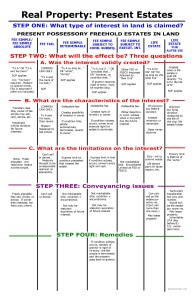
This chart is presented as five separate images which can be printed out on 11×17″ sheets of paper (or smaller) and displayed side-by-side so that they make one massive chart showing the characteristics of every type of interest in land. For each type, a step-by-step analysis is presented. The first step, of course, is to identify the interest in land. In Step Two, we ask three questions to determine what effect the interest will have: A. Was the interest validly created?; B. What are the characteristics of the interest?; and C. What are the limitations on the interest? In Step Three, we examine any applicable conveyancing issues, and in Step Four we examine any applicable remedies. A blank in the diagram does not necessarily mean that, for instance, there is no applicable remedy, just that I did not have a special rule to add.
The first chart shows present possessory freehold estates in land, including fee simple/fee simple absolute, fee tail, fee simple determinable, fee simple subject to condition subsequent, fee simple subject to executory interest, life estate, and life estate pur autre vie.
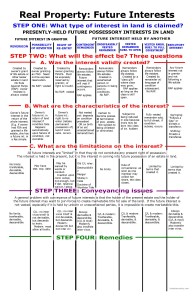
Next we look at presently-held future possessory interest in land, including future interests held by the grantor, such as reversion, possibility of reverter, and right of re-entry, and future interests held by another, such as contingent remainder, indefeasibly vested remainder, vested remainder subject to open, vested remainder subject to full divestment, and executory interest.
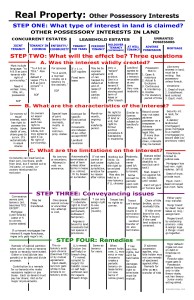
The third section of the chart lists other possessory interests in land, including concurrent estates such as joint tenancy, tenancy in common, and entirety/community; leasehold estates such as tenancy for years, periodic tenancy, holdover tenancy (sufferance), and at will tenancy; and unwanted possessors, as with adverse possession or mortgage.
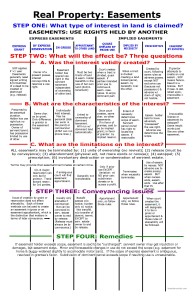
The fourth section deals with easements, including express easements, such as by express grant, by express reservation, in gross, or appurtenant to other land, and implied easements such as quasi-easements implied by prior use, implied by necessity, prescriptive easements, and easements by estoppel.
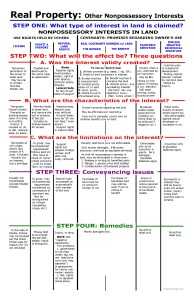
The fifth and final section lists other nonpossessory interests in land, including use rights held by others, such as licenses, profits a prendre, and natural land rights; covenants, equitable servitudes, and implied negative reciprocal servitudes.
Real Property Present Estates pdf
Real Property Future Interests pdf
Real Property Other Possessory Interests pdf
Real Property Easements pdf
Real Property Other Nonpossessory Interests pdf

Credit/link to brendanconley.com.
Great Help, Thank you
THANK YOU!!
Hi thank you so much for this amazing flash cards. Just wondering what is “SOF”? since you don’t provide explanation
Hi Jay! That would be Statute of Frauds. Yeah I kind of went overboard with the abbreviations since I originally made these just for myself. Glad they’re helpful to you!
Statute of Frauds
Thank you for sharing your concise and helpful outlines. Much appreciated.
Brendan, thank you for putting this material together.
Amazing! Thank you so much